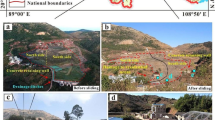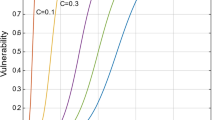Abstract
Urban landslides always occur where development has taken place on pre-existing unstable land. Due to rapid urbanization, human activities expand onto sloping terrain and disturb the geological environment, increasing the urban landslide risk. When a rapid flow-like landslide occurs, the landslide mobility can be affected by the presence of buildings located along its flow path. In this paper, the effect of building blockage on landslide mobility and the associated energy dissipation mechanisms are evaluated based on a well-documented landslide, which happened on 20 December 2015 in Shenzhen, China. The landslide flow process is reproduced by three-dimensional terrain analyses using LS-DYNA, considering three scenarios; namely, green field, movable buildings, and fixed buildings. Simulations show that the presence of densely located buildings significantly affects flow pattern, travel distance, deposition, and energy transfer mechanism. A fully developed debris fan in the flat area is observed in the green field case. The buildings in the runout path decelerate the flow process, leading to lower landslide mobility and less volume deposited in the accumulation zone. The shortest runout distance and widest and thickest deposits are observed in the fixed buildings case. The debris fan in the movable buildings case is closer to reality. Fixed buildings pose more constraint on surface moving material, leading to the largest deformation, largest internal energy, and smallest kinetic energy of the soil mass. The dissipation of the largest frictional energy occurs in the movable buildings case due to the long sliding distance of the damaged buildings. The internal energy of the landslide mass dominates the energy transfer mechanism. The results presented here indicate the need to consider building clusters when conducting urban landslide hazard mapping and risk assessment.














Similar content being viewed by others
References
Alexander D (1989) Urban landslides. Prog Phys Geogr 13(2):157–189
Coduto D (2001) Foundation design. Prentice Hall, New Jersey, pp 259–300
Dang K, Sassa K, Konagai K, Karunawardena A, Bandara RMS, Hirota K, Tan QW, Ha ND (2019) Recent rainfall-induced rapid and long-traveling landslide on 17 May 2016 in Aranayaka, Kagelle District, Sri Lanka. Landslides 16(1):155–164
Dikau R, Brunsden D, Schrott L, Ibsen ML (1996) Landslide recognition: identitication, movement and causes, international Association of Geomorphologists, Publication No. 5, John Wiley and Sons, Chichester, 1996, 251
Gao L, Zhang LM, Chen HX, Shen P (2016) Simulating debris flow mobility in urban settings. Eng Geol 214:67–78
García DH, Machuca S, Medina E (2019) Dynamic and geomorphic characterizations of the Mocoa debris flow (March 31, 2017, Putumayo Department, southern Colombia). Landslides 16(3):597–609
Hallquist JO (2006) LS-DYNA theory manual. Version 971. Livermore: software technology corporation
Hu KH, Cui P, Zhang JQ (2012) Characteristics of damage to buildings by debris flows on 7 August 2010 in Zhouqu, Western China. Nat Hazards Earth Syst Sci 12(7):2209–2217
Hungr O (1995) A model for the runout analysis of rapid flow slides, debris flows, and avalanches. Can Geotech J 32(4):610–623
Hungr O, Evans SG (1996) Rock avalanche runout prediction using a dynamic model. In proceedings of the 7th Int. Symp. on Landslides, Trondheim. Norway 11:233–238
Kean JW, Staley DM, Lancaster JT, Rengers FK, Swanson BJ, Coe JA, Hernandez JL, Sigman AJ, Allstadt KE, Lindsay DN (2019) Inundation, flow dynamics, and damage in the 9 January 2018 Montecito debris-flow event, California, USA: Opportunities and challenges for post-wildfire risk assessment. Geosphere. https://doi.org/10.1130/GES02048.1
Koo RCH, Kwan JS, Lam C, Goodwin GR, Choi C, Ng CWW, Yiu J, Ho KKS, Pun WK (2017) Back-analysis of geophysical flows using 3-dimensional runout model. Can Geotech J 55(8):1081–1094
Kwan JSH, Koo RCH, Ng CWW (2015) Landslide mobility analysis for design of multiple debris-resisting barriers. Can Geotech J 52(9):1345–1359
Lacasse S, Nadim F (2009) Landslide risk assessment and mitigation strategy. In Landslides–Disaster Risk Reduction. Springer, Berlin, Heidelberg, pp 31–61
Li G, Lei Y, Yao H, Wu S, Ge J (2017) The influence of land urbanization on landslides: an empirical estimation based on Chinese provincial panel data. Sci Total Environ 595:681–690
Li X, Wu Y, He S, Su L (2016) Application of the material point method to simulate the post-failure runout processes of the Wangjiayan landslide. Eng Geol 212:1–9
Luo HY, Zhang LL, Zhang LM (2019) Progressive failure of buildings under landslide impact. Landslides 16(7):1327–1340
Luo HY, Zhang LM (2018) Simulation of building failure by landslide impact. In Proceedings of China-Europe Conference on Geotechnical Engineering. Springer, Cham, 23–26 August 2018, pp. 1500–1503
Martha TR, Kumar KV (2013) September, 2012 landslide events in Okhimath, India—an assessment of landslide consequences using very high resolution satellite data. Landslides 10(4):469–479
Mavrouli O, Corominas J (2010) Vulnerability of simple reinforced concrete buildings to damage by rock falls. Landslides 7(2):169–180
Moore R, McInnes R (2016) The impacts of landslides on global society: planning for change. In: In Landslides and engineered slopes: experience, theory and practice. Proceedings of the 12th International Symposium on Landslides, Napoli, Italy, pp 1461–1468
Olshansky RB, Rogers JD (1987) Unstable ground: landslide policy in the United States. Ecol Law Quart 13(4):939–1006
Ouyang C, Zhou K, Xu Q, Yin J, Peng D, Wang D, Li W (2017) Dynamic analysis and numerical modeling of the 2015 catastrophic landslide of the construction waste landfill at Guangming, Shenzhen, China. Landslides 14(2):705–718
Qiao C, Ou GQ, Pan HL, Ouyang CJ, Jia Y (2018) Long runout mechanism of the Shenzhen 2015 landslide: insights from a two-phase flow viewpoint. J Mt Sci 15(10):2247–2265
Quan Luna B, Blahut J, Van Westen CJ, Sterlacchini S, van Asch TW, Akbas SO (2011) The application of numerical debris flow modelling for the generation of physical vulnerability curves. Nat Hazards Earth Syst Sci 11(7):2047–2060
Schuster RL (1996) Socioeconomic significance of landslides. Landslides: investigation and mitigation. Washington (DC): National Academy Press. Transp Res Board Special Rep 247:12–35
Skempton AW (1985) Residual strength of clays in landslides, folded strata and the laboratory. Geotechnique 35(1):3–18
Sosio R, Crosta GB, Hungr O (2008) Complete dynamic modeling calibration for the Thurwieser rock avalanche (Italian Central Alps). Eng Geol 100(1–2):11–26
Tiwari B, Upadhyaya S (2014) Effect of rainfall and building construction on a marginal slope in triggering landslide. In Landslide Science for a Safer Geoenvironment, Springer, Cham, pp 313–318
Varnes, DJ (1978) Slope movement types and processes. Landslides, Analysis and Control, edited by: R.J. Schuster and R.J. Krizek. Special Report 176, Transportation Research Board, National Academy of Sciences, Washington, DC, 11–33
Xing A, Xu Q, Zhu Y, Zhu J, Jiang Y (2016) The August 27, 2014, rock avalanche and related impulse water waves in Fuquan, Guizhou, China. Landslides 13(2):411–422
Xu Q, Peng D, Li W, Dong X, Hu W, Tang M, Liu F (2017) The catastrophic landfill flowslide at Hongao dumpsite on 20 December 2015 in Shenzhen, China. Nat Hazards Earth Syst Sci 17(2):277–290
Yang H, Xia J, Thompson JR, Flower RJ (2017) Urban construction and demolition waste and landfill failure in Shenzhen, China. Waste Manag 63:393–396
Yin YP, Li B, Wang W, Zhan L, Xue Q, Gao Y, Zhang N, Chen H, Liu T, Li A (2016) Mechanism of the December 2015 catastrophic landslide at the Shenzhen landfill and controlling geotechnical risks of urbanization. Engineering 2(2):230–249
Zhang LM, Gao L, Chen HX (2016) Vulnerability of buildings to landslides: impact loads and failure mechanisms. Keynote lecture. In: Proceedings of 5th international conference on forensic geotechnical engineering. Bengaluru, India, pp 36–47
Zeng C, Cui P, Su Z, Lei Y, Chen R (2015) Failure modes of reinforced concrete columns of buildings under debris flow impact. Landslides 12(3):561–571
Funding
This study was supported by the Science and Technology Plan of Shenzhen (No. JCYC20180507183854827) and the Research Grants Council of the Hong Kong SAR (Nos. T22-603/15N and C6012-15G).
Author information
Authors and Affiliations
Corresponding author
Rights and permissions
About this article
Cite this article
Luo, H.Y., Shen, P. & Zhang, L.M. How does a cluster of buildings affect landslide mobility: a case study of the Shenzhen landslide. Landslides 16, 2421–2431 (2019). https://doi.org/10.1007/s10346-019-01239-y
Received:
Accepted:
Published:
Issue Date:
DOI: https://doi.org/10.1007/s10346-019-01239-y




